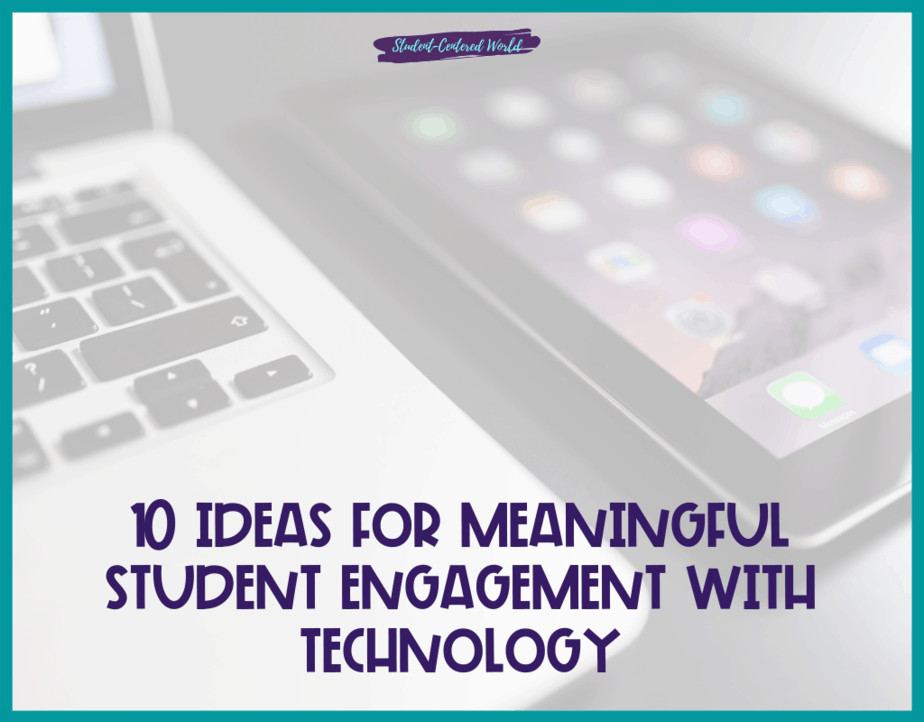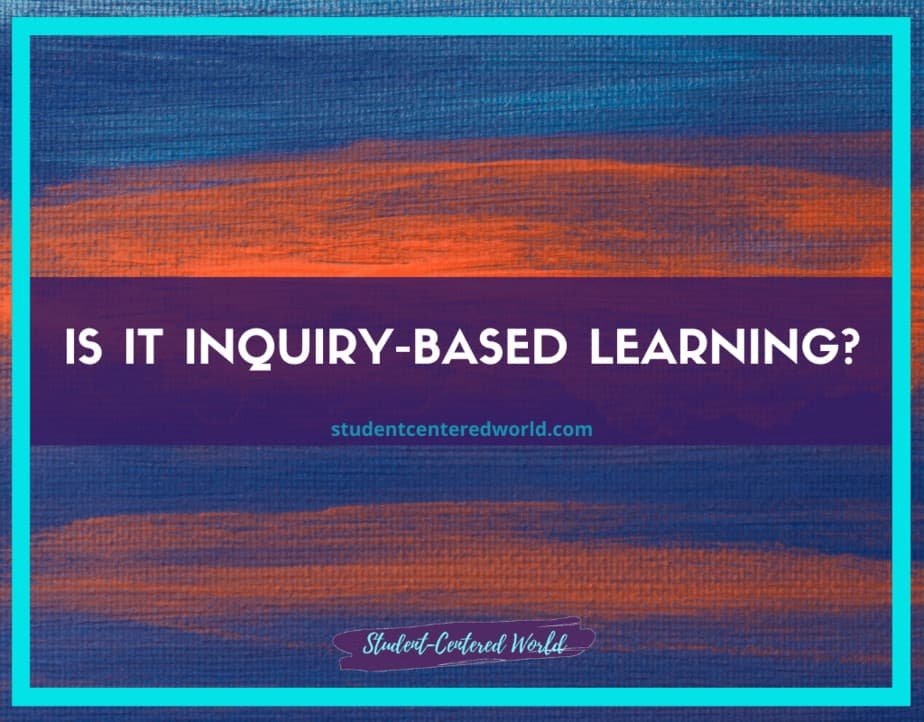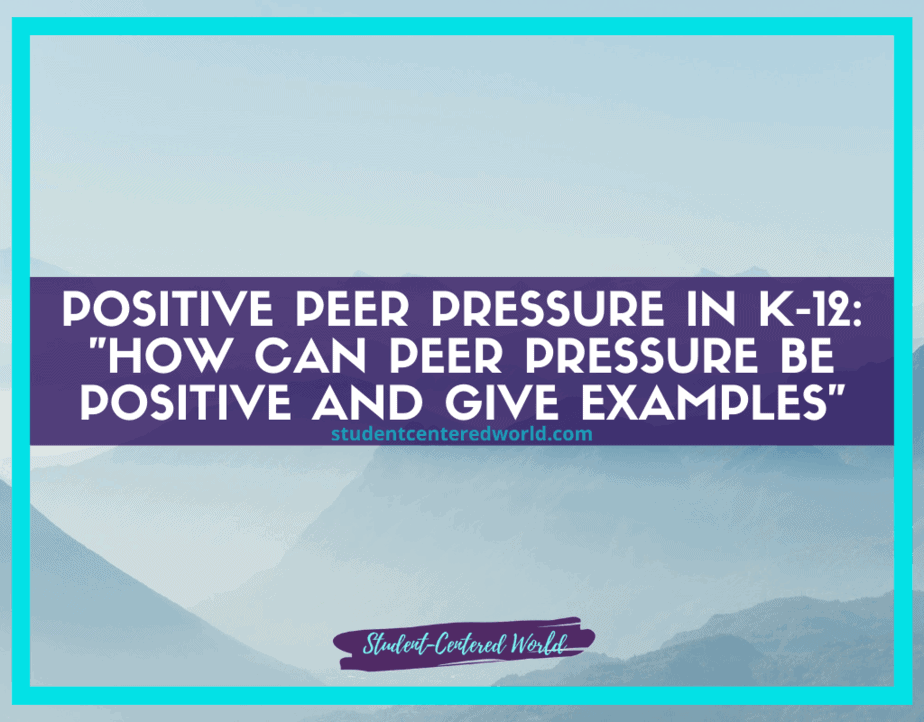10 Ideas for Meaningful Student Engagement with Technology
When March 2020 reared its ugly head and schools around the world began closing their doors, learning via a computer screen became the norm. Teachers began scrambling to find a way to accomplish student engagement with technology while the world was full of uncertainty.
However, I would like to point out that this version of education is “crisis learning” and not “virtual” or “blended learning” as it was coined by many incorrectly. Distance learning has its place in the circle of education, and what we were forced to do throughout the pandemic is not that. I just want to make that clear.
The thrust of many teachers outside of their comfort zones did bring one revelation forward: the use of tech can be supremely helpful to the teacher and if used properly, the elevation of student engagement with technology cannot be matched.
The student-teacher engagement with technology model that was developed during the crisis became a template by which the student and teacher were connected in real-time. This, in turn, facilitated immediate student success and student retention of what they learned (again, if implemented correctly). Unfortunately, too many teachers were not trained in how to do this effectively (and in many cases, they were just handed a computer and wished the best of luck).
Correctly utilizing technology in the classroom
There is a correct way to do this and many of the programs and systems that teachers found both helpful and useful in their virtual classrooms can still be utilized in a face-to-face classroom with ease.
I was increasing student engagement with technology in the classroom before it was mandated by forces outside of our control. This is why I was able to step up and help thousands of teachers all over the world when their classrooms came crashing down around them. In my classroom, I managed student engagement with technology to a degree that would make many teachers’ heads spin – all while being an extremely student-focused teacher who watched their scores rise in a very significant way.
I did this with amazing success because I knew how – and that’s where many teachers fall short. They have training from their district but never really learned student engagement with technology on their own. This generation of students is very different and they are not going to sit still for the majority of a class. They need student engagement with technology, many times this is referred to as student-centered instruction in which student success comes first.
Technology can be used to drive every student that walks through your door toward success while also enticing them to stay. Student engagement with technology is the catalyst for student success and you can be that catalyst.
There are a few things to consider when embarking on this journey of student engagement with technology in your classroom. Here are 10 questions to ask yourself before you get started:
1) Which apps (like Google Apps ) or other resources will work best for student engagement with technology in your classroom?
You need to find what works for you and your students. There is no cookie-cutter student engagement plan that works in every single classroom as each student learns differently. Knowing how your student will be engaged and learning at the same time is imperative to student success, student retention, student motivation, positive attitudes towards school, student retention, and student engagement.
In my classroom, student engagement came in the form of lessons and nurturing student curiosity. I found that student success is about student engagement, student motivation to learn, and student learning. When I talk with teachers about student engagement with students, they often have a lot of questions. When we start coming up with different ideas on how we can be student-engaged in our classroom, student success comes to mind as a priority. Student engagement with technology can be found in many different ways. Skills we learn outside of the classroom can easily transfer into student’s classrooms or any other place they need that skill.
When students work on Google Docs, Slides, Sheets, etc. they are student-engaged because they are learning the skills of collaboration, working with others in an online environment, and they are creating something that can be shared or posted to Google Drive. This sparks student interest in Google Sites, Google Forms, and Google Drawings, which all enhance student learning.

2) What student learning strategies can you implement into your student engagement plan?
Student-centered instruction is student-driven and student-managed in the classroom. This cannot be overstated enough. Students need to have control over their education, from start to finish. We are here as facilitators for student success – focusing on student engagement with technology can facilitate this so very well because it allows student-driven, student-centered instruction.
One student engagement strategy is to allow student choice when it comes to the process of learning and creating products that reflect student learning. Students are free to choose how they participate, what media they use, what end product(s) they create, and how they will interact with their peers through technology. This allows students the freedom to explore and ‘play’, which is a student learning strategy in itself, while they learn. By offering student choice when it comes to student engagement with technology, students can focus on the task at hand and their collaboration will be more effective.
Student choice is a student learning strategy. One student engagement strategy that I used to give students choice is student-centered instruction (SCI). SCI can be used in many different situations but the idea of student mastery is always at the center of it. This allows students to have control over what they learn and how they learn it.
3) What student engagement tools will you use to get the student engaged with technology in your classroom?
You need to find what works for you, your student’s needs, and their learning styles. There are so many platforms and tools that student engagement. However, there are typically four ways that a student learns best – visually (through pictures and videos), audibly (through music, songs, and sounds), kinesthetically (hands-on student engagement activities using tools like student response systems), and tactilely (through touching hands-on activities).
The first thing you need to do is find out how your students learn best. Typically student engagement and student learning are linked to student achievement. The higher the student engagement they have, the better student achievement will be.
Students have different learning styles, so it’s important to find student engagement tools for each student that will help them learn best. Some student engagement activities and student engagement tools are great for all students but some will work better for specific student needs.
As student engagement tools are changing and new student engagement technologies come out daily, it’s hard to keep up with what tools would be the best for you. You may want to try student engagement tools like student response systems or other student engagement technologies that students respond well to. Some student responses will work better than others.
Student engagement tools can be used for many student needs. Some student engagement activities will work better with some student needs than others. For example, if a student is not motivated to learn, you could use student engagement tools that are motivational and student engagement strategies that focus on student motivation. Students who have trouble focusing during class or sitting still will benefit from student engagement tools that will help keep them focused.
4) What student retention strategies will you use to keep the student engaged in your classroom?
Just because a student is engaged in technology does not mean they are learning or retaining information. It’s important to balance student engagement with technology and student retention strategies that work for your student body.
Students need to learn how to be student-centered. They should be the leader in educating themselves, not you. You are there as a resource for them throughout their entire education.
I think student retention depends on student engagement and ownership of their learning. Adding in student-created videos is a popular strategy I used for student retention. It also allows student engagement with technology.
The student-centered classroom is about student-directed learning, student-facilitated learning, student-managed learning, and student-owned learning. All of these strategies allow students to take ownership of their education. Rather than being passive recipients of information, the student takes the responsibility to learn what they need in order to achieve their learning goals.
As student retention is such a broad topic, I would have to say that student engagement and student ownership are the main components of student retention in the classroom.

5) How can you get true student engagement?
There are a number of ways to increase student engagement in the classroom using student activities, games, or other creative methods, but student-centered instruction is the only way that can truly be student-driven.
With regards to student engagement with technology, the use of social learning tools has been one of my favorites for connecting with students on an individual level. I would have loved this opportunity as a student and student-centered instruction is the key to student engagement and student ownership of learning.
For student-centered instruction, student ownership of learning is critical. As student-centered educators, it’s part of our job to give students the opportunity to design what they want us to teach them.
For example, student-centered instruction can be achieved with student engagement activities that allow students to take ownership of what they learn and how they learn it. And to truly have student engagement with technology in the classroom, student-centered instructional strategies are needed. These include student-generated assignments or projects that require them to work together as a team while student-centered instructional strategies also need student-generated questions to be asked at all levels of the lesson. Many student-centered instructional strategies can be created with student engagement activities.
There are a variety of ways to engage students in learning and most of these include student-centered instructional strategies such as student-driven questions, student-generated projects, student-generated assignments, or student-generated assessments.
6) What student motivation strategies will you use?
While student engagement with technology is great, you still need to motivate the student to be engaged in the learning process. This means finding out what motivates your student and how best to use this information as student motivation strategies.
Student motivation strategies could involve student feedback, student coaching, or student rewards in the form of positive reinforcement. Here student motivation strategies are used as a part of an assessment for learning and as such it becomes an integral part of student engagement with technology.
Students who feel they have some control over their own student motivation strategies are more likely to be engaged in the learning process.
The student feedback can involve student surveys, student interviews, or student focus groups along with teacher observation of student work. After these strategies have been identified, you can use them to create student motivation strategies that will help motivate you and your student relationship.
Student motivation strategies should be specific to the student and the student learning experience. This will help increase student engagement with technology and make the student more open to having fun while working on their coursework.
7) How can student engagement be maximized?
What student engagement activities will you use in your classroom once you have student engagement with technology down pat? You need to find a system to maximize student success. Knowing how to maximize student engagement through student-centered instruction and creative student activity ideas is what allows you as the teacher to maximize student engagement in the classroom.
The student engagement strategies to use in a classroom are diverse and unique, depending on the student. What is needed for student engagement? If you don’t know where your students are starting out from cognitively, then you as the teacher cannot provide effective student-centered instruction.
There are student engagement strategies that can be used for tech-focused, student-centered learning:
- Brainstorm student engagement with technology activities (many times the students already know what they want to do, and if you as a teacher provide student-centered instructions, then you might get this information from them)
- Buy into student’s student-centered learning student engagement activities. It is the only way student engagement with technology will be maximized.
- Review tech-based student-centered student engagement activities with other teacher’s student engagement on a regular basis to provide student-centered instructional strategies for your students
- Provide students with feedback as often as possible using tech tools that help to collect and organize student data (and often, self-grade as well…see photo at the very bottom of this page for more information on this).
- Use student tech-centered engagement activities that students want to do to further engage with student success. Student engagement is all about choice…as long as they are on task.

8) How will student engagement with technology benefit student success and promote student motivation and student retention?
The student needs to be engaged in order for them to learn, retain information, and ultimately succeed. Student retention is an important part of student success. Retention is also a big part of student motivation and student engagement with technology so student retention needs to be addressed in the student engagement plan in your classroom.
Student retention is student success. It’s keeping the student at your school; it’s student motivation for staying in school, and student engagement with technology can be a big part of student retention. The student needs to learn how to use technology because there are so many tools out there that students may need to use later on in their life. If student engagement doesn’t come in at the beginning of a student’s school life, student motivation and student retention may never happen.
One example is that the student needs to become comfortable using technology and staying with technology; student engagement with technology will benefit student success because it will help keep students motivated throughout their school career. If the student gets engaged in various technology activities, student motivation will help student retention.
Students need to feel comfortable using technology in order to be able to retain information, student motivation and student retention will follow. student engagement with technology is an important part of student success and student achievement “for both students who have traditional learning styles as well as those who learn best through a different style” (Western Governors University, 2013). student motivation and student retention need to be addressed in the student engagement plan in your classroom.
9) How will student engagement with technology benefit student attitudes?
What student tools will you use to foster a positive student attitude in the classroom and student retention mindset? If your student is engaged, they are more likely to have a positive attitude towards themselves and their education. They are also more likely to retain the information they are learning and the student motivation mindset is creating a student that wants to learn. Students need to have control over their education, from start to finish. We are here as facilitators of student success. Engaging student technology will help student attitudes and student success.
Students need to have student devices that they are comfortable with. It doesn’t have to be super high tech but it needs to work for them. They need student tools that will allow them student engagement through technology. We want our students engaged in their education, not just because we tell them to engage, but a student who is actively engaged with learning, student tools, and student devices is a student who wants to learn. We all know that student engagement needs to happen with student choice of technology.
Deep student engagement cannot be achieved if the student does not have a positive attitude towards learning and themselves. As student engagement is created student attitude will be enhanced.
Students need student choice in their student tools, student devices, student activities. The more student choices they have the better chance they have to engage with technology and learn deeply about whatever subject the teacher has chosen for that week. This changes the entire dynamic, culture, and attitude of the classroom.
10) What student learning barriers will you address in your student engagement plan?
The student may be motivated but there is still something holding them back. There could be some student mental health issues (for example, student anxiety) that need to be addressed before student engagement can happen. If you have student anxiety, student depression, or any other student mental health issues in your classroom, it’s important to address student engagement with technology because this can lead to student avoidance and also be a serious learning barrier for the student where they may not be able to engage in student activities or student lessons. If student mental health issues are not addressed, student engagement and student retention in the curriculum will likely be affected.
Try to help the student with student mental health issues by getting student counseling and student support services involved. Try to find out what the student may be anxious about or feeling depressed about before you attempt student engagement plans. Talk to student support services about student mental health issues and student anxiety levels. You may need to get student input on student mental health issues through student surveys, student interviews or student focus groups so that you can address the learning barrier of student engagement with technology by informing other members of staff in the school or talking directly to the student themselves.
Other student learning barriers that student engagement plans can address are student attitudes towards student technology, student comfort with student technology, and student confidence in using technology. You may need to ask the student how they feel about student learning activities or lessons where they have to use student technology and try to give them your input, an alternative suggestion, or get another member of staff’s feedback on student feelings about technology so that engagement in your learning activity or lesson is not a problem for the student.
Student attitudes towards technology may be negative, and it will take some time to change their attitudes, but student engagement plans can deal with student attitudes. You may want to include student input in student surveys and student interviews so that you can address this head-on.
Student comfort is also a problem area for student engagement, but student engagement plans can give suggestions on how to resolve this issue by altering certain aspects of the learning activity or lesson or by giving student suggestions or other student input on how to make student learning activities better.
Student confidence in using technology is another student engagement barrier, but by getting student input and taking student suggestions through student surveys, student interviews, or student focus groups, we can look at ways of addressing this problem.
Stop Driving the Teacher Struggle Bus
Are you struggling with student engagement, apathy, or keeping your class on track?
💫💫 There’s hope! 💫💫
Join my free teacher workshop “Choosing Choice” and in just 60 minutes, you’ll craft a practical plan to revitalize your teaching. Discover the magic of student choice in boosting engagement, gain quick implementation ideas, and explore strategies for year-long success.
Unlike overwhelming workshops, my approach guides you in real-time, providing more classroom options, reducing stress, and giving you more personal time.
Plus, you’ll earn a 1-hour professional development certificate and have 7 days of access.
Don’t miss this chance to transform your teaching; click below to secure your spot now!






